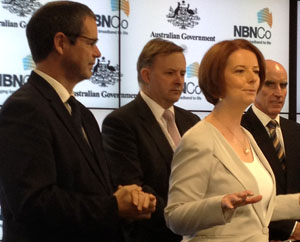NBN 3-year plan covers 3.5m premises

Prime Minister Julia Gillard today announced the three-year roll-out plan for the National Broadband Network (NBN), which expects to cover 3.5 million premises and most Labor, Liberal and cross-bench seats by 2015.

Stephen Conroy, Anthony Albanese, Julia Gillard and Mike Quigley
(Credit: Josh Taylor/ZDNet Australia)
The roll-out plan for the next three years will cover a total of 1500 communities, Gillard announced in Sydney today, saying the NBN was "about to go into high gear".
New South Wales is the big winner, with 1.01 million premises expected to be connected to the NBN by 2015, followed by Victoria at 691,600, Queensland with 678,600, Western Australia with 429,200, South Australia with 327,300, ACT with 135,300, the Northern Territory with 65,200 and Tasmania with 209,100. The combined numbers cover approximately one-third of the entire roll-out.
NBN Co has set up a roll-out map where people can look up to see whether their suburb will be connected in the next three years.
The three-year indicative plan has been released following the finalisation of the $11 billion deal with Telstra that will see its copper network retired and customers moved onto the NBN. NBN Co could only release the three-year plan once it had assessed the dark fibre, ducts and exchanges it will lease from the telco giant for the NBN.
In expectation of criticism from suburbs that missed out on being included in the initial three-year plan, NBN Co CEO Mike Quigley explained how exactly NBN Co determined the suburbs picked.
"First we needed to complete the sites we had already announced. We had to take into account the instructions our shareholder, the government, gave to us, which was to get a balance between regional and metro areas. And also to achieve a balance across the states of Australia and also to complete Tasmania by 2015," Quigley said.
"We had to build our plan on the basis of the infrastructure that was available from Telstra," he added.
NBN Co also had to prioritise "growth corridors", where there would be the majority of greenfields sites so NBN Co could get those done as efficiently as possible. The company also had to prioritise links that were essential for the operation of the fixed-wireless network and the satellite earth stations in preparation for these networks to be in place by 2015.
Quigley said the company then had to "load balance" for construction contractors and adjust the build to prevent congestion in local communities. Meanwhile, it had to ensure that James Cook, New England, Wollongong and Melbourne universities had access to fibre as they are researching high-speed broadband applications.
Communications Minister Stephen Conroy said that 67 of the 72 Labor seats, 61 of the 71 Coalition seats and six of the seven independent seats will be covered by the roll-out.
Gillard said that it was time to retire the ageing Telstra copper network.
"Whilst our 100-year-old copper telephone network has served us well, it cannot deliver the broadband we need for the future. If we don't move as a nation to the National Broadband Network, then we will see choked off the economic possibilities of the future and we will see choked off the service delivery possibilities of the future," Gillard said.
"Wherever you are scheduled in the roll-out of the NBN, your access to broadband is not safe if the government changes. Tony Abbott has been very clear that he wants to demolish the National Broadband Network. The only way to ensure that broadband is there ... is for our government to continue that mission."
The NBN three-year plan goes past the next election, which, on the basis of polling today, the Gillard Government is likely to lose to the Coalition. The Coalition has proposed to scale back the NBN roll-out significantly. Conroy said that the NBN roll-out wouldn't stop in the election period and said Opposition Leader Tony Abbott's plan to buy Telstra's copper for a fibre-to-the-node network was "rooted in the last century" and ignores the bandwidth demand across Australia.
"The copper is strangling our economy," Conroy said.
Although the government is talking up the fact that the copper network will be retired as part of the NBN roll-out, Quigley could not say when or where the first parts of the copper network will be deactivated. Once an area is declared "ready for service" on the National Broadband Network Telstra will switch off the copper network in 18 months. However, Quigley indicated that Telstra CEO David Thodey wanted to switch it off faster.
Conroy also said that the government's decision on whether it will provide battery back-ups for all premises on the NBN is expected to be made in May.